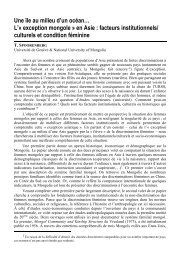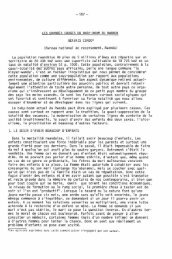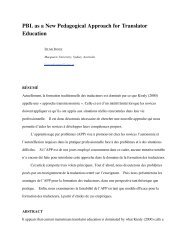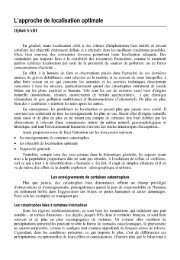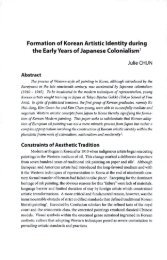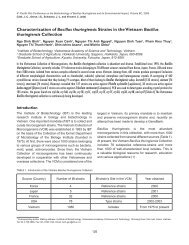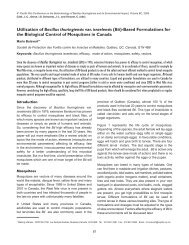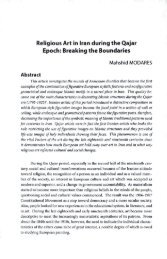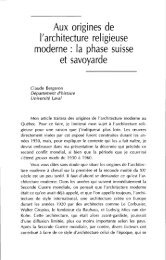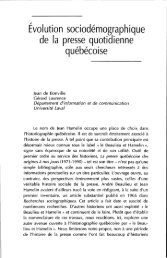A Proactive Approach to the Translation of Bible Stories for Children
A Proactive Approach to the Translation of Bible Stories for Children
A Proactive Approach to the Translation of Bible Stories for Children
Create successful ePaper yourself
Turn your PDF publications into a flip-book with our unique Google optimized e-Paper software.
In terms <strong>of</strong> reading development, <strong>the</strong> members <strong>of</strong> middle childhood fall in<strong>to</strong> <strong>the</strong> second <strong>of</strong><br />
Retief’s (1990:36) four stages:<br />
0 – 5 yrs: Preschool reader (picture books)<br />
6 – 8 yrs: Beginner reader (picture books)<br />
9 – 11 yrs: Transition away from picture books<br />
12+ yrs: Juvenile literature<br />
There is significant language development during middle childhood. This not only involves<br />
an increased vocabulary and more complex sentence structures, but also <strong>the</strong> improved ability <strong>to</strong><br />
adapt language and style <strong>of</strong> language <strong>to</strong> <strong>the</strong> context in which it is used. For instance, <strong>the</strong> child’s<br />
language while speaking <strong>to</strong> her teacher will differ from <strong>the</strong> language she uses when speaking <strong>to</strong> a<br />
friend. Also, between <strong>the</strong> ages <strong>of</strong> three and four, preschool children begin <strong>to</strong> understand figurative<br />
expressions such as, “<strong>the</strong> clouds look like castles”. By school going age (roughly at <strong>the</strong> beginning<br />
<strong>of</strong> middle childhood), children understand metaphorical language such as, “<strong>the</strong> sun is like a piece<br />
<strong>of</strong> glowing coal” and, “a heart <strong>of</strong> gold” (Mussen, Conger, Kagan & Hus<strong>to</strong>n 1990).<br />
As <strong>for</strong> dreaming, R<strong>of</strong>fwarg, Muzio and Dement (1966) found that neonates spend about half<br />
<strong>of</strong> <strong>the</strong>ir sleeping time in REM (rapid eye movement) sleep, associated with dreaming. And <strong>the</strong><br />
processing <strong>of</strong> dreams has been done during gestalt play <strong>the</strong>rapy with children as young as six years<br />
<strong>of</strong> age (Blom 2004: 165). This <strong>of</strong>ten helps children <strong>to</strong> develop new strategies <strong>for</strong> coping with<br />
emotions such as fear and anger. This type <strong>of</strong> <strong>the</strong>rapy is used <strong>to</strong> great effect <strong>for</strong> children grieving<br />
(losing a loved one <strong>to</strong> AIDS, <strong>for</strong> example) and traumatised children (<strong>for</strong> instance, in cases <strong>of</strong> rape,<br />
abandonment, physical violence, extreme poverty, etc.) in <strong>the</strong> South African context 12 .<br />
Some <strong>of</strong> <strong>the</strong> most important symp<strong>to</strong>ms (Blom 2004:214) that may be experienced by such<br />
children include nightmares, fear <strong>of</strong> strangers, changes in <strong>the</strong>ir eating and sleeping patterns,<br />
extraordinary fear <strong>of</strong> <strong>the</strong> dark, fear <strong>of</strong> separation or <strong>of</strong> being alone 13 . Papalia & Olds (1979: 302)<br />
explain <strong>the</strong> development <strong>of</strong> new fears in <strong>to</strong>ddlers as follows: “They know so much more now, and<br />
one <strong>of</strong> <strong>the</strong> things <strong>the</strong>y know is that <strong>the</strong>re are a lot <strong>of</strong> things <strong>to</strong> be afraid <strong>of</strong>. Then, <strong>to</strong>o, <strong>the</strong>ir<br />
imaginations go wild, and <strong>the</strong>y are worried about being attacked by a lion, being in <strong>the</strong> dark, being<br />
abandoned, or falling from high places.”<br />
4.5 The Text in <strong>the</strong> Hebrew <strong>Bible</strong><br />
Eugene Nida (2003:76) has pointed out that instead <strong>of</strong> simply lecturing about principles <strong>of</strong><br />
correspondence between <strong>the</strong> source text and <strong>the</strong> target text, <strong>the</strong> translation process is far better<br />
served by a scholar conferring with a prospective transla<strong>to</strong>r, by going through <strong>the</strong> text <strong>to</strong>ge<strong>the</strong>r as a<br />
means <strong>of</strong> discovering and anticipating potential problems <strong>for</strong> <strong>the</strong> prospective translation. In fact, he<br />
says, this is one <strong>of</strong> <strong>the</strong> most important procedures, because a problem recognized and accurately<br />
identified, is already half solved. This anticipation <strong>of</strong> difficulties in translating is particularly useful<br />
as a transla<strong>to</strong>r is <strong>the</strong>reby prepared <strong>for</strong> potential hiccups that may arise in <strong>the</strong> text and can prepare<br />
accordingly. As a result <strong>the</strong> translating process usually proceeds more rapidly and with fewer<br />
problems. Nida’s suggestion is easily extrapolated <strong>to</strong> accommodate <strong>the</strong> present authors’ approach<br />
<strong>to</strong> translating children’s bibles: taking cognisance <strong>of</strong> <strong>the</strong> cognitive life world <strong>of</strong> both <strong>the</strong> source and<br />
target cultures, as well as <strong>the</strong> necessary interplay <strong>of</strong> both text and picture in <strong>the</strong> translation activity.<br />
South African children’s bibles are most <strong>of</strong>ten translated from American and British English<br />
translations, with little <strong>to</strong> no cognisance given <strong>to</strong> cultural specificity in <strong>the</strong> South African target<br />
culture. The American or British children’s bible is in turn usually derivative from an “adult”<br />
English translation <strong>of</strong> <strong>the</strong> Hebrew source text. Never<strong>the</strong>less, it was found that, in most instances, <strong>the</strong><br />
English “adult” text pretends <strong>to</strong> <strong>the</strong> position <strong>of</strong> source text, <strong>the</strong>reby ignoring <strong>the</strong> Hebrew/Aramaic<br />
or Greek source text.<br />
As children’s bibles lean heavily on images as necessary partners in <strong>the</strong> conveyance <strong>of</strong><br />
message, we suggest that transla<strong>to</strong>rs <strong>of</strong> children’s bibles pay closer attention <strong>to</strong> <strong>the</strong> source texts,<br />
with <strong>the</strong> assistance <strong>of</strong> transla<strong>to</strong>rs, <strong>for</strong> <strong>the</strong> selection <strong>of</strong> s<strong>to</strong>ries, <strong>the</strong> translation <strong>of</strong> text and <strong>the</strong><br />
translation <strong>of</strong> image. To illustrate our strong emphasis on illustration as part and parcel <strong>of</strong>



